Agrotourism - Kayaking the Mangroves at Bang Rong
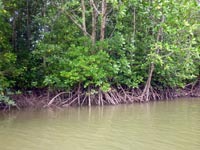 Everyone knows Phuket has
great beaches and rugged forest covered hills. It would be difficult for
any visitor to miss these obvious geographical features of the island. What
most visitors don't see or even know is that the east coast of Phuket
still has large areas of dense mangrove forest. It is not surprising the
tourists prefer the beaches to the mangroves. Mangrove forest is not a very
hospitable environment for people. However, it is an important habitat for
many species of flora and fauna. It also gives coastal areas important protection
from erosion and tsunamis.
Everyone knows Phuket has
great beaches and rugged forest covered hills. It would be difficult for
any visitor to miss these obvious geographical features of the island. What
most visitors don't see or even know is that the east coast of Phuket
still has large areas of dense mangrove forest. It is not surprising the
tourists prefer the beaches to the mangroves. Mangrove forest is not a very
hospitable environment for people. However, it is an important habitat for
many species of flora and fauna. It also gives coastal areas important protection
from erosion and tsunamis.
We say there are large areas of mangrove forest but it has to be admitted that it is an ever-diminishing feature of Phuket. Developers and land-grabbers are slowly claiming the mangrove forest and turning it into hotels, housing projects or prawn farms. As always seems to be the case, the drive to make money takes precedence over protecting the environment. Fortunately, there are plenty of environmentally conscious people in Phuket who do want to protect this unique and important habitat and are working hard towards this aim.
The Agrotourism project at Bang Rong pier is a fabulous example of such work. Here local people are working together on a project that creates a tourist attraction, makes money for the local people and protects the environment. This really is a win-win and we fully support the project.
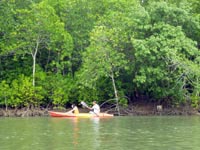 The idea is simple. Take tourists for kayaking tours around the mangroves.
Phuket does not have any waterways that are grand enough that you could call
them a river. However, the mangroves at Bang Rong are fortunate enough to
have several kilometres of sea inlets meandering through them. It is a perfect
location to take tourists for a tour through a mangrove forest.
The idea is simple. Take tourists for kayaking tours around the mangroves.
Phuket does not have any waterways that are grand enough that you could call
them a river. However, the mangroves at Bang Rong are fortunate enough to
have several kilometres of sea inlets meandering through them. It is a perfect
location to take tourists for a tour through a mangrove forest.
Bang Rong is a community of about 1,000 people on the east coast of Phuket. The mostly Muslim population have always strived to hang on to their cultural heritage and they try to cater to the needs of tourists without compromising their own way of life. They are a self-sustaining community and are very aware of the importance of the mangroves. The mangroves protected them from the tsunami in 2004. They are a source of food and other products. They provide shelter and are the base for the local pier. Eighty percent of the local population are reliant on the mangroves in some form or other.
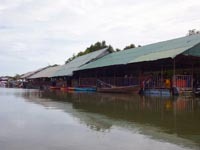 So to help protect this precious resource the local people got together
and created the Agrotourism project. They built a restaurant and base at
the Bang Rong pier. It is a simple wooden structure built on stilts over
the water. You can hire a kayak and have a guide to paddle you around for
only 200-baht an hour. If you are more independently minded you can hire
your own kayak and paddle yourself for 150-baht an hour.
So to help protect this precious resource the local people got together
and created the Agrotourism project. They built a restaurant and base at
the Bang Rong pier. It is a simple wooden structure built on stilts over
the water. You can hire a kayak and have a guide to paddle you around for
only 200-baht an hour. If you are more independently minded you can hire
your own kayak and paddle yourself for 150-baht an hour.
As you paddle away from the restaurant you pass a few small fish farms. The sea inlet is wide and there are mangroves on both banks. Within a few minutes the buildings are out of sight and you only have the mangroves for company. The waterway forks and you have a choice of going left or going around a large island. The waterway to the left allows you to paddle for a couple of kilometres until it slowly narrows to nothing but a stream. You might want to stick to the tree line as you go to avoid the full glare of the sun. Now you can really appreciate the mass of intertwined roots and the lush foliage above.
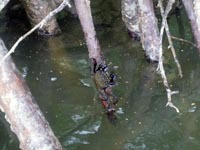 This is the area where the guides can really come into their own, spotting
small camouflaged fauna such as tree crabs. These are the small black
crabs that Thais like to smash into their somtam. The water often ripples
as fish jump from the surface.
This is the area where the guides can really come into their own, spotting
small camouflaged fauna such as tree crabs. These are the small black
crabs that Thais like to smash into their somtam. The water often ripples
as fish jump from the surface.
Mangroves are a harsh environment. The Salinity level is often greater than seawater. Very few large mammals inhabit these areas as the protruding roots are difficult and painful to navigate. You do find tree-dwellers such as monkeys in some mangrove areas. People certainly are not suited to living in mangrove forests but there are some species that are specifically adapted to these areas. It is an important nursery ground for many marine species. Some shellfish use the roots as anchors while shrimps and mud lobsters inhabit the muddy bottom.
As you paddle along the main waterway, you see a few small streams that offshoot into the forest. You can just about navigate down a few of them. You can then turn around and paddle back along the opposite bank. Do a loop of the island before heading back to base. An hour is about right but you could spend more time if you really wanted to delve into every nook and cranny.
Once you get back to the restaurant, why not take the chance to try some of the fresh local seafood.
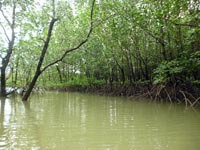 The locals hope this project will not only be a sustainable use of the mangroves
earning money for the community without damaging the environment. They also
hope it will actually contribute to the protection of the environment as
both guides and tourists will be constantly monitoring the forest and will
spot any encroachments.
The locals hope this project will not only be a sustainable use of the mangroves
earning money for the community without damaging the environment. They also
hope it will actually contribute to the protection of the environment as
both guides and tourists will be constantly monitoring the forest and will
spot any encroachments.
This project is creating genuine jobs for local people. They hope it will help some of the local youth remain in the area and carry forward their way of life for future generations.
It is a bit of a journey to reach Bang Rong for just an hour's kayaking but there are other attractions in the area. One of the good things about the east coast is that it is sheltered from the rainy season waves so this is an all year round attraction. If you come during the rainy season then you could combine the trip with a visit to Bang Pae Waterfall.
Alternatively, you could hire a longtail boat at the pier and visit Naka Island or maybe take the ferry to Koh Yao Noi.
How to Get There
Bang Rong Pier is on the east coast of Phuket. From south Phuket you turn right at Heroines Monument. Drive for around 12km until you see the sign for the right hand turn to the pier.
